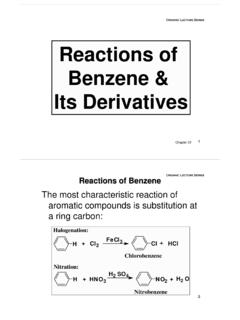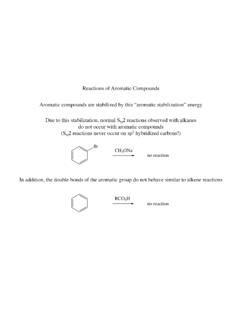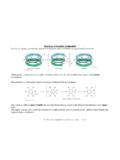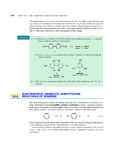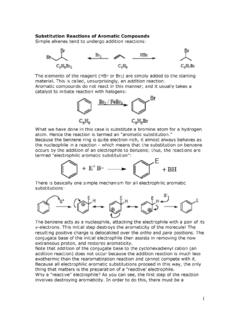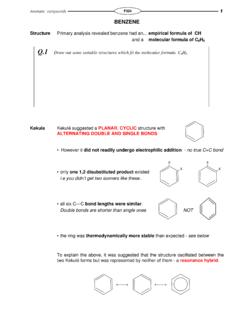Transcription of Organi II Mechanisms - Organic chemistry
1 Organic II Mechanisms 1. Alkadienes a. HX addition to a conjugated diene: b. General Diels-alder cycloaddition reaction(Diene must be in cis configuration): 2. Aromatics a. electrophilic aromatic substitution (halogenation): b. electrophilic aromatic substitution (Nitration): c. electrophilic aromatic substitution (Sulfonation): d. electrophilic aromatic substitution (Alkylation): e. electrophilic aromatic substitution (Acylation): f. Nucleophilic substitution reaction of aryl halides with EWG (Meisenheimer complex; ortho/para only): g. Preparation of phenol from halobenzene via benzyne: 3. Alcohols a. 3o alcohol- acid catalyzed dehydration: b.
2 2o, 3o alcohol dehydration with POCl3: c. 3o alcohol to alkyl halide using HX (X= Cl, Br, I): d. 1o, 2o alcohol to alkyl halide using SOCl2: e. 1o, 2o alcohol to alkyl halide using PBr3: 4. Ethers a. Acid catalyzed synthesis of symmetrical ethers (1o alcohols only): b. Williamson ether synthesis (1o or 2o R X only; can be intramolecular): c. Alkoxymercuration of alkene to form ethers: d. Acidic cleavage of ethers(1o and 2o ethers; HI or HBr only): e. Claisen rearrangement of an allyl aryl: f. Alkenes with peroxyacid: g. Alkene with X2/H2O and a strong base: h. Acid-catalyzed epoxide ring opening(X=F, Br, Cl or I): i. Base-catalyzed epoxide ring opening (Sn2) : 5.
3 Aldehydes/Ketones a. Nucleophilic addition to a ketone or aldehyde: b. Grignard(RMgX) addition to a ketone or aldehyde: c. Hydride addition to a ketone or aldehyde: d. 1o amine addition to a ketone or aldehyde (Imine formation): e. 2o amine addition to a ketone or aldehyde (Enamine formation): f. Wittig Reaction: g. Conjugate addition of a nucleophile to an , -unsaturated aldehyde or ketone: Nu=RNH2, R2NH, R2 CuLi(R:-), -:CN enolate 6. Carboxylic Acids/Nitriles a. Carboxylation of Grignard reagent to prepare carboxylic acids: b. Nitrile with an organometallic reagent: 7. Carboxylic Acid Derivatives a. Conversion of carboxylic acid into acid chloride: b.
4 Conversion of carboxylic acid into acid anhydride: c. Conversion of carboxylic acid into an ester ( 2 ways): Sn2 Route Fischer esterification d. Conversion of carboxylic acid halides into carboxylic acids, esters, amides, aldehydes, ketones, or alcohols: (Y= Cl, Br) e. Conversion of carboxylic acid anhydrides into carboxylic acids, esters, amides, or alcohols: (Y= O2CR) f. Conversion of esters into carboxylic acids, amides, or alcohols: (Y= OR) g. Conversion of amides into carboxylic acids: (Y= NH2, NHR, NR2) 8. Carbonyl -Substitutions a. Base catalyzed enolate formation: b. Acid catalyzed enol formation: c. -halogenation of a carbonyl (aldehydes/ketones only): d.
5 Hell-Vollhard-Zelinski (HVZ) reaction (carboxylic acids only): e. Haloform reaction (methyl ketones only): f. Alkylation of enolates, esters and ketones (Sn2 reactions): g. alkylation of nitriles: h. Malonic ester synthesis: i. Acetoacetic ester synthesis: 9. C a r b o n y l C o n d e n s a t i o n s a. General carbonyl condensation reaction: b. Base catalyzed dehydration of an aldol: c. Acid catalyzed dehydration of an aldol: d. Intramolecular aldol condensation reaction: e. Claisen condensation reaction: f. Dieckmann cyclization (intramolecular Claisen condensation): g. Michael addition reactions: h. Stork enamine reaction: Reverse of enamine formation yields: i.
6 Robinson annulation reaction (Combination of Michael rxn 1st, followed by an intramolecular Aldol rxn): See intramolecular aldol rxn above for the mechanism of part 2. 10. Amines a. Azide synthesis of a primary amine: b. Gabriel synthesis of an amine: c. Reductive amination of aldehydes and ketones.
